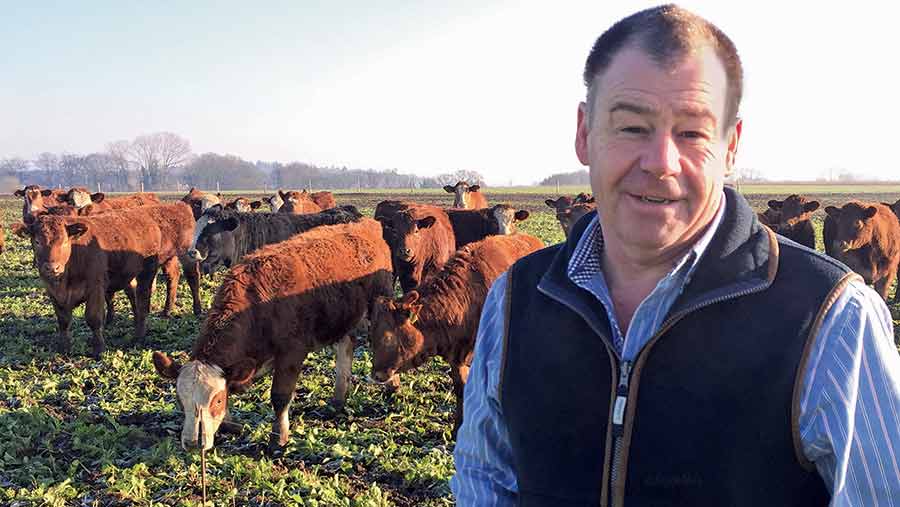Paddock grazing helps beef farmer halve finishing costs

Paddock grazing is allowing a suckler beef producer to halve his finishing costs an animal to less than £1/day.
Andrew Crow runs a herd of 150 Stabiliser cows plus followers at Cherrington Manor, Newport, Shropshire, and sells the beef through his butchery business.
He converted from high input finishing to a grass-based system because it allows him to run higher numbers of breeding stock to absorb high fixed costs.
There were other key reasons too. “We need the quality of grass-fed beef for our own shop,’’ Mr Crow explains. “Putting grass back into the arable rotation for two years at a time also widens our rotation and improves soil structure and organic matter.
“We can now finish cattle on a grass paddock system from the new grass leys in the arable rotation or from high-quality silage in the winter.’’
See also: Canadian beef farmer improves soil by mob grazing
Grass leys
Twenty hectares of new grass leys are in the arable rotation as two-year leys so 10ha of land is reseeded annually.
Each area is split into four or five paddocks of two to three hectares, depending on the shape of the field or the position of the water source.
When a new grass ley is established, the outside is fenced with high-tensile pig netting and a single strand of electric fence. This allows for paddocks to be split again or strip grazed over winter if there is an excess of grass.
Pig netting is also used to create the internal paddock fencing, with three-staple posts set at 10m apart. “We can easily remove all internal fences in less than a day by wrapping them up into 500m rolls using the same quick fencer we put them up with,’’ says Mr Crow.
Between 50 and 60 of the largest steers – those weighing 400kg or more – graze the first paddock. These steers will have been outwintered on catch crops planted in harvested potato fields.
“We turn them into the paddocks once a wedge of grass has built up because the last thing we want is to run out of grass and have to change the diet by buffer feeding,’’ says Mr Crow.
Target cover for the start of grazing is 3,300kg DM/ha, with a residual of 1,500kg DM/ha.
The latest Aber grasses with herbs and clover are used to establish the short-term leys. The soil index and pH are all managed within the arable rotation, with potash at index 2 and phosphates at 3-4. Nitrogen plus sulphur is applied three or four times in the first year, at 50kg/ha.
“The clover really kicks in during late summer, especially in the second year,’’ says Mr Crow.
Grass is measured weekly and once there is an excess of grass, paddocks are taken out of the rotation for silage. The aim is to keep the cattle on the perfect sward heights to produce the fastest growth rates and for there to be no wastage of grass.
Cattle are usually moved to a fresh paddock after a week but it depends on grass growth. “Steers are moved once the grass cover drops to 1,500kg DM/ha,’’ says Mr Crow.
“We allow four paddocks per 50 cattle with extra grass made into round-bale silage.’’
A full recording system for Mr Crow’s ewe flock and finished lambs was introduced last year and the same software is being used in the cattle herd this year. Every time an animal goes through the handling system it can be weighed and recorded.
Benefits
Since the paddock grazing system was established, Mr Crow’s steers are achieving growth rates of more than 1.2kg/day from grass only over their lifetime, with each steer consuming between 12kg and 15kg of dry matter daily.
And finishing feed costs have more than halved from nearly £2/day for the previous diet of maize, barley, oil seed rape meal, beet pulp and minerals, to under £1/day for grass and silage.
These figures confirm the advantages of paddock grazing to Mr Crow’s business but there are some drawbacks, he admits.
“The set up costs for all the fencing is high and I have concerns about how much time will be needed to utilise all the information to its full potential.’’
See also: Nine-step guide to setting up a beef grazing rotation
With the system now in place, Mr Crow aims to double cow numbers to 300. He also plans to shift the mainly spring calving pattern to 50% late summer calving to fully use the Stabiliser bulls he buys in and to allow for the poorer grass over the summer to be managed by dry cows.
Next winter silage bales will be left in the grass fields earmarked for spring crops and these fields will be strip grazed. Forage rye will be planted after potatoes then one cut will be round baled and left there while a wedge of rye is built up for strip grazing the cows over the winter.
